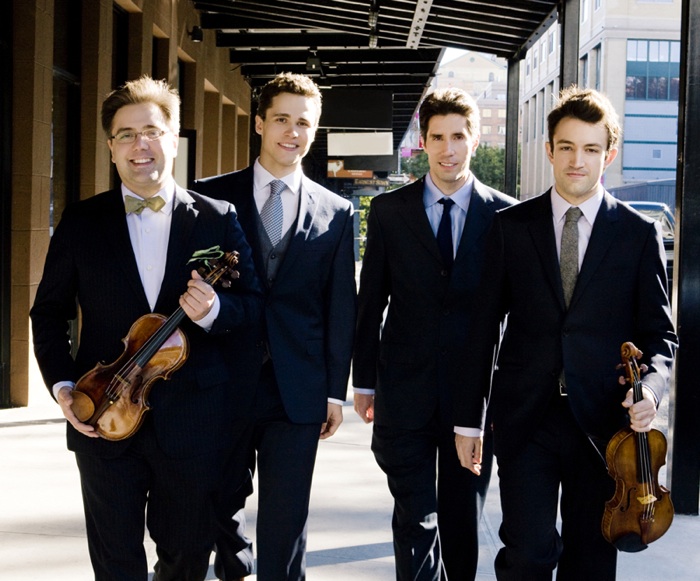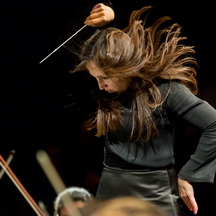From frogs to dead flies—a compelling quartet at Kohl Mansion
Burlingame’s Music at Kohl Mansion welcomed the Escher Quartet to its Great Hall last Sunday, Nov. 16. This young foursome, with their magnificent technique and monumental interpretation, is at the height of their powers: last year they won a prestigious Avery Fisher career grant, highlighted Music@Menlo’s summer festival, and championed the four Zemlinsky quartets with two just-released new CD’s.
Early concertgoers were invited to listen to a master class as the Escher coached the newly formed Saratoga String Quartet, four precocious teens whose names may one day grace programs. As they played the ferocious first bars of a Prokofiev quartet, violinist Adam Barnett-Hart interrupted them with suggestions on the dramatic underpinning of repeated notes. “Go wild! Be free!” he urged violinists Aku Sorensen and Jason Moon.
Violist Pierre Lapointe gave pointers to Linus Lu on a seamless join in a blistering passage, making them play it over and over, and cellist Dane Johansen reminded them of balance. “And don’t lose the motion,” he told cellist Irene Jeong, “even when it’s soft. Keep the motion.” This preview let us glimpse their inner life, the hard work and thought that inform every bar.
And then their own program, which nicely balanced the camaraderie of Haydn, the bitter knife’s edge of Shostakovich, and the golden lilt of Dvořák. As they indicated as mentors, their contrasts and colors came close to self-parody—but never beyond—with lush chords and crisp finishes, sharp up-bows and delicate chirps, crystalline high notes and massive lows.
Joseph Haydn’s “The Frog” quartet, so named because of a note repeated on open and fingered strings for the in-and-out call of a frog, was a gentle gemütlichkeit, a supportive exchange that is pure Haydn. Barnett-Hart brought fluid clarity to his virtuosic passages, never outshining the moment, and the lower strings leaned in with comments and friendly chords.
In the Adagio they sang of sorrow, but carefully controlled it, with personality breathed into every violin passage and a clean suppleness to the high cello line. After a witty minuet came the spirited finish, with Barnett-Hart and fellow violinist Aaron Boyd paralleling scorching passages.
We were flushed and ripe for Dmitri Shostakovich’s 15th and final quartet, a fearless meditation on Death. Boyd stood to speak.
“Since your program notes are so fine [by annotator and pre-concert lecturer Kai Christiansen], I’ll only talk of the personal. When we play this quartet, it brings to mind the writings of Edward Said… and the question of resolution. Unlike Schubert’s Winterreise, which is essentially romantic, Shostakovich spends six movements staring into the face of Death. It is so acidic and frigid it is frozen in time.”
“Shostakovich wrote, ‘Play the first movement so that flies drop dead in mid-air and the audience leaves the hall out of boredom.’ Well, [laughter] we want you to think of it as an experience, not just a piece.”

Boyd sat and began the work with a repeated low E-flat, grim and devoid of vibrato. The others gradually filtered in, overlapping to build generous timbres, but still in a world of brittle and slate. As the three lower strings united in soft drone, the violin reached across in fragile harmonics, open intervals like a far-off trumpet playing taps.
The movements ran together, marked by moments of beauty and rage and long passages of transparent loneliness. There were huge mono-tonal resonances, like Ad Reinhardt’s black on black paintings, and musical figures that skated thinly across ice.
This was, simply, a gift.
And after that E-flat minor, the Escher Quartet turned to E-flat major with Dvořák’s String Quartet No. 10 for a contented romp in the fields of Bohemia. Dvořák was both violist and an ethnomusicologist with a love of Czech folk idioms, and so here, Lapointe’s plucked viola stood in as a lute in a country dance, and then led a stirring lament, a “dumka.”
To sweeten our palate, they encored with the second movement of Ravel’s Quartet in F major. It was coloristic, an airy froth of pizzicatos and birdcalls and tremolos, and very French—whole tones and lots of cream!
—Adam Broner
Photo of the Escher Quartet, from left, violinists Aaron Boyd, cellist Dane Johansen, violist Pierre Lapointe and violinist Adam Barnett-Hart; photo by Laura Rose.
